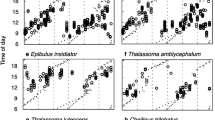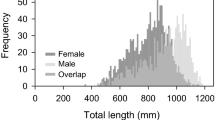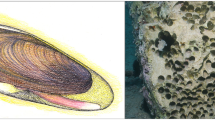Abstract
Temporal patterns in giant barrel sponge (Xestospongia muta) spawning were compiled from 32 observations spanning 17 years and three Caribbean locations (Florida, Belize, and Haiti). The records were analyzed for patterns in seasonality, lunar periodicity, and diel rhythm to develop a predictive spawning window. Results indicate that spawning is concentrated from mid-April to late May. Most spawning events occurred around the first quarter moon; a smaller pulse occurred just before the third quarter moon. All spawning events were observed in the morning and fell within 779–987 min of the previous night’s sunset. Eggs of X. muta were all negatively buoyant and blanketed the areas within and surrounding the sponge; this limited gamete dispersal may be the driver behind heavily localized genetic retention.



Similar content being viewed by others
References
Agostinelli C, Lund U (2017) R package circular: Circular Statistics (version 0.4–93), CA: Department of Environmental Sciences, Informatics and Statistics, Ca’Foscari University, Venice, Italy. UL: Department of Statistics, California Polytechnic State University, San Luis Obispo, California, USA
Amano S (1986) Larval release in response to a light signal by the intertidal sponge Halichondria panicea. Biol Bull 171:371–378
Amano S (1988) Morning release of larvae controlled by the light in an intertidal sponge, Callyspongia ramosa. Biol Bull 175:181–184
Atkinson S, Atkinson MJ (1992) Detection of estradiol-17β during a mass coral spawn. Coral Reefs 11:33–35
Bell JJ (2008) The functional roles of marine sponges. Estuar Coast Shelf Sci 79:341–353
Bell JJ, Smith D, Hannan D, Haris A, Jompa J, Thomas L (2014) Resilience to Disturbance Despite Limited Dispersal and Self-Recruitment in Tropical Barrel Sponges: Implications for Conservation and Management. PLoS ONE 9:15
Bernard AM, Finnegan KA, Shivji MS (2019) Genetic connectivity dynamics of the giant barrel sponge, Xestospongia muta, across the Florida Reef Tract and Gulf of Mexico. B Mar Sci 95:161–175
Brady A, Hilton J, Vize P (2009) Coral spawn timing is a direct response to solar light cycles and is not an entrained circadian response. Coral Reefs 28:677–680
Chaves-Fonnegra A, Maldonado M, Blackwelder P, Lopez JV (2016) Asynchronous reproduction and multi-spawning in the coral-excavating sponge Cliona delitrix. J Mar Biol Assoc UK 96:515–528
Deignan LK, Pawlik JR, López-Legentil S (2018) Evidence for shifting genetic structure among Caribbean giant barrel sponges in the Florida Keys. Mar Biol 165:106
Fromont J, Bergquist P (1994) Reproductive biology of three sponge species of the genus Xestospongia (Porifera: Demospongiae: Petrosida) from the Great Barrier Reef. Coral Reefs 13:119–126
Harrison PL, Babcock RC, Bull GD, Oliver JK, Wallace CC, Willis BL (1984) Mass Spawning in Tropical Reef Corals. Science 223:1186–1189
Hoppe WF, Reichert MJM (1987) Predictable annual mass release of gametes by the coral reef sponge Neofibularia nolitangere (Porifera: Demospongiae). Mar Biol 94:277–285
Jansen C, Peper C, Beek P (2000) Limitations of the scanning procedure in assessing changes in coordination dynamics due to learning. In: Dessain P, Windsor L (eds) Rhythm perception and production. Swets & Zeitlinger, The Netherlands, pp 51–68
Lamoth C, Beek PJ, Meijer OG (2002) Pelvis–thorax coordination in the transverse plane during gait. Gait & posture 16:101–114
Landler L, Ruxton GD, Malkemper EP (2018) Circular data in biology: advice for effectively implementing statistical procedures. Behav Ecol Sociobiol 72:128
Levitan DR, Fogarty ND, Jara J, Lotterhos KE, Knowlton N (2011) Genetic, spatial, and temporal components of precise spawning synchrony in reef building corals of the Montastraea annularis species complex. Evolution 65:1254–1270
Lindquist N, Bolser R, Laing K (1997) Timing of larval release by two Caribbean demosponges. Mar Ecol Prog Ser 155:309–313
Loh T-L, Pawlik JR (2014) Chemical defenses and resource trade-offs structure sponge communities on Caribbean coral reefs. Proc Natl Acad Sci USA 111:4151–4156
McMurray S, Blum JE, Pawlik JR (2008) Redwood of the reef: growth and age of the giant barrel sponge Xestospongia muta in the Florida Keys. Mar Biol 155:159–171
McMurray SE, Finelli CM, Pawlik JR (2015) Population dynamics of giant barrel sponges on Florida coral reefs. J Exp Mar Biol Ecol 473:73–80
R Core Team (2013) R: A language and environment for statistical computing. Austria, Vienna
Reiswig HM (1970) Porifera: sudden sperm release by tropical Demospongiae. Science 170:538–539
Reiswig HM (1976) Natural gamete release and oviparity in Caribbean Demospongiae. In: Harrison FW, Cowden RR (eds) Aspects of sponge biology. Academic Press, New York, pp 99–112
Richards VP, Bernard AM, Feldheim KA, Shivji MS (2016) Patterns of population structure and dispersal in the long-lived “redwood” of the coral reef, the giant barrel sponge (Xestospongia muta). Coral Reefs 35:1097–1107
Richmond RH, Jokiel PL (1984) Lunar periodicity in larva release in the reef coral Pocillopora damicornis at Enewetak and Hawaii. B Mar Sci 34:280–287
Ritson-Williams R, Becerro MA, Paul VJ (2005) Spawning of the giant barrel sponge Xestospongia muta in Belize. Coral Reefs 24:160
Röthig T, Voolstra CR (2016) Xestospongia testudinaria nighttime mass spawning observation in Indonesia. Galaxea, Journal of Coral Reef Studies 18:1–2
Sarano F (1991) Synchronised spawning in Indonesian sponges. Coral Reefs 10:166–166
Swierts T, Peijnenburg KTCA, de Leeuw CA, Breeuwer JAJ, Cleary DFR, de Voogd NJ (2017) Globally intertwined evolutionary history of giant barrel sponges. Coral Reefs 36:933–945
Twan W-H, Hwang J-S, Chang C-F (2003) Sex steroids in scleractinian coral, Euphyllia ancora: implication in mass spawning. Biol Reprod 68:2255–2260
van Woesik R (2010) Calm before the spawn: global coral spawning patterns are explained by regional wind fields. Proceedings of the Royal Society B: Biological Sciences 277:715–722
van Woesik R, Lacharmoise F, Köksal S (2006) Annual cycles of solar insolation predict spawning times of Caribbean corals. Ecol Lett 9:390–398
Vermeij GJ, Grosberg RK (2018) Rarity and persistence. Ecol Lett 21:3–8
Zea S (1993) Cover of sponges and other sessile organisms in rocky and coral reef habitats of Santa Marta, Colombian Caribbean Sea. Caribb J Sci 29:75–88
Acknowledgements
We are grateful to the contributors of spawning observations including J. Pawlik, S. McMurray, C. Walter, K. Maxwell, P. Darche, E. Bartels, J. Renchen, D. Morley, G. Renchen, J.E. Hart, N. McIntyre, M. Bollinger, L. Carne, C. Lewis, V. McDonough, N. McIntyre, M. Miller, N. Dancho, and Jupiter Dive Center. We thank J. Butler, J. Stein, G. Delgado, and B. Crowder for their insightful comments on the manuscript and also J. Pawlik and two anonymous reviewers for their suggestions and revisions.
Author information
Authors and Affiliations
Corresponding author
Ethics declarations
Conflict of interest
On behalf of all authors, the corresponding author states that there is no conflict of interest.
Additional information
Publisher's Note
Springer Nature remains neutral with regard to jurisdictional claims in published maps and institutional affiliations.
Topic Editor Anastazia Teresa Banaszak
Electronic supplementary material
Below is the link to the electronic supplementary material.
Rights and permissions
About this article
Cite this article
Neely, K.L., Butler, C.B. Seasonal, lunar, and diel patterns in spawning by the giant barrel sponge, Xestospongia muta. Coral Reefs 39, 1511–1515 (2020). https://doi.org/10.1007/s00338-020-02009-2
Received:
Accepted:
Published:
Issue Date:
DOI: https://doi.org/10.1007/s00338-020-02009-2




